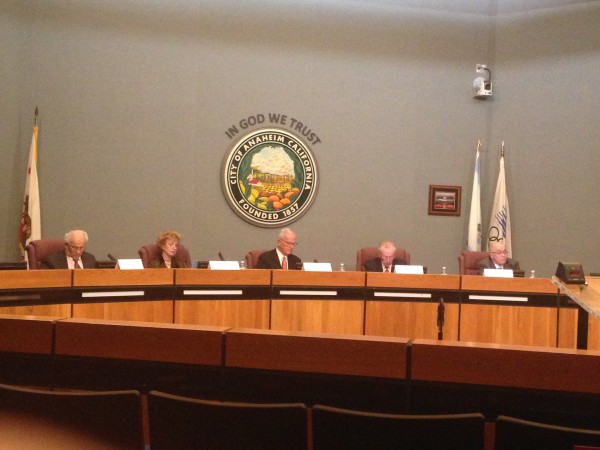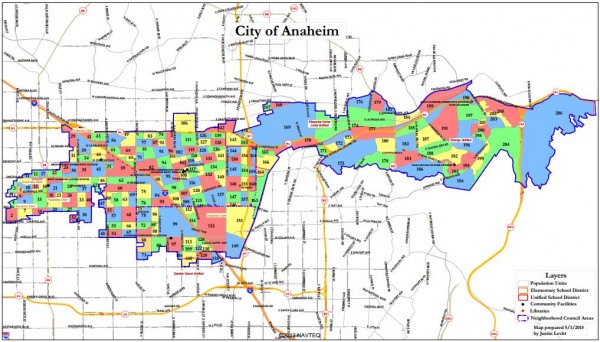.
.
.

Your Advisory Committee on Electoral Districts! From left to right: Judges James Jackman of Orange, Nancy Wieben Stock of Fullerton, Vice-Chair Stephen Sundvold of Placentia, Thomaas Thrasher of Villa Park, and their Chair Justice Ed Wallin of Anaheim, getting up to speed on using the Council Chambers microphone system.
I can’t remember the last time I’ve heard more requests for information about what happened at a public meeting that I have in the hours since the inaugural meeting of the Anaheim’s Advisory Committee on Electoral Districts. So, well aware of the narrow scope of the likely audience for this one and the stinging repartee that it no doubt headed my way for writing about it to slake my friends’ inexorable search for knowledge, I will tell you the story.
First: they met. Most of what you need to know is in the photo caption. Most of what isn’t there can be found on the brand new page on Anaheim.net, which will be found at www.anaheim.net/districts.
It seems like a decent and well-intentioned group of volunteer public servants — and I suspect that, by the end, some of us may regret that all of their efforts are merely going to be advisory. But, the better job they do, the harder it will be for the Council to change their result.
The Committee was guided through the process by City Clerk Linda Andal, getting a rare chance to appear in the Council Chambers in more than a cameo role and doing a good job of keeping the jurists on track. They were also assisted by Ben DeMaio, a former Counsel with the County of Orange who had an air about him of being tasked to keep close tabs on the process, and a competent-seeming demographer from San Diego named Justin Levitt.
Levitt’s report was quite helpful in introducing the legal and technical issues at hand between now and early October, when the report must be finalized and submitted to the Council. With this meeting, the Committee entered the second stage of its process, which goes beyond “getting ready” to “getting going” before reaching “getting everything done.”
Part one of this stage involves getting information from the public about what they care about, which when it comes to districting largely involves identifying their “communities of interest.” In other words, if you live at the intersection of South and West streets — ha ha, trick hypothetical, they don’t intersect! — who else nearby you do you consider to be the people with whom you share your concerns about what is happening in the city, so that you ought to be part of the same voting district. It could be people with whom you share recreational or shopping facilities, ethnic or political ties, or whatever else strikes you as a reasonable answer to that question.
So: you’re going to go to their next few meetings and tell them what you think about that. Or, you aren’t — if the future meetings are going to be like this one was, the turnout will not be overwhelming. (But hopefully that will change.)
All meetings, thus far, as set for 6:30 p.m., but they are trying to vary the days and may eventually have a Saturday meeting or two for those who have difficulty making it otherwise. The first three meetings are on May 27, June 4, and June 9; the June 4 meeting is tentatively scheduled to be somewhere outside in the wild community somewhere, such as the Western part of the City. Then the demographer will start to prepare his proposals in light of community feedback, and these will be presented at two meetings on July 1 (in Council Chambers) and July 8 (where they are aiming for a site in South or East Anaheim), prior to the neighborhood Council meetings in the third week of July.
Over the next month or so, at a minimum, people will be allowed (even encouraged) to submit their own districting proposals. The City has set up a software program that you can use to do this. If you take on the challenge, you will assign “census block groups” to six districts, using a map like this as a guide:
Because these maps will be the first ever used to set up Anaheim’s city voting districts, their influence is expected to be especially strong. They will be used in elections through the 2020 election cycle as well as special elections up until the 2022 general election.
I spent quite a few joyful hours romping with the system since it was announced last night — and it’s pretty cool. (I’m not showing you them yet — soon, it will be soon.) So good luck, figure out your communities of interest, and get going!








THe same Ben DiMaio who advised the OC County Board of Supervisors that it was perfectly legal to hide the Citizen Voting Age Population numbers from the public? PEOPLE NEED TO BE CONCERNED!
Can you provide definitive details on this? I would think that the Committee would be interested if this is more than a rumor and if his advise was truly improper rather than a judgment call about which dataset to use or something.
And do we have anyone out there with actual knowledge who would address this publicly using their actual name? Judges are not big on pseudonyms.
This comment has been made before. I was an alternate on that committee and I don’t remember this issue even coming up; and maybe it should have.
DiMaio’s contribution to the County redistricting was negligible and maybe should have been more – given his billing rate. He got that job because he was County Counsel when the previous redistricting took place in 2000.
*This looks like a wonderful attempt at fulility if we have ever seen it. Dr. Gerrymander himself would be proud. How many paint by number pieces are necessary to develop a convoluted nonsensical system like this. Someone please advise these great minds that when you develop seven districts for any city….each district needs to be contiguous to the next one. Take the pie and divide it into seven pieces….but don’t use a Sushi knife to create the districts….OK? Why do all of these “great minds” always want to “re-invent the wheel”. Go look at the other 22 cities in California that already know how to do this stuff..please! Advisory board…eh? Yeah, sounds good to us!
What’s with the big ass “In God We Trust” slogan plastered above the seal? What does god have to do with the city of Anaheim, generally, and this process, specifically?
City Council Districts Headed in the Wrong Direction
The first public meeting is only a few days away. Thus, on May 20th, I reviewed the maps and other info. on the Committee’s Web page and sent them an email that day requesting clarification and noting some map problems. The only response as of today, is that my question was forwarded to the Committee. From their lack of response, they are not very interested in getting informed, thoughtful input from the public stakeholders.
Text from my E-Mail: “What is the logic behind only allowing proposed changes in yellow areas? Additionally, Many of the public services are missing on the western end of the East District Map( Rio Vista Elementry and two parks. Also the Proposed/funded Homeless Shelter just north of the 91 fwy and west of Kraemer Ave. is missing)”.
Why is this important? The Committee maps look as if they are tilted to demographically build the council districts. Without any significant consideration to other neighborhood considerations (the things that make a neighborhood like density, shopping, work, income, schools, parks, traffic, etc.). Having elected officials that have their jobs primarily based on ethnicity factors is not a good idea. We need well rounded leaders who are focused on all of our neighborhood problems. Not just those based on one criteria.